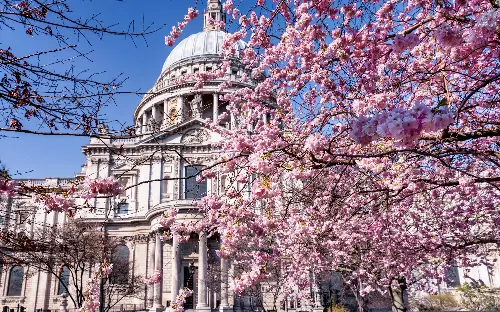
There’s no need to visit Japan for cherry blossom season. Now that hanami – the centuries-old tradition of flower viewing – is firmly fixed in the UK’s national calendar, parts of London are (for a few precious weeks) abuzz with people taking selfies beneath clouds of pink and white petals.
Cherry blossom starts to appear at the end of March and continues throughout April, before the flowers shed their petals like confetti. London’s most famous cherry blossoms include the blousy tresses of pale-pink outside St Paul’s Cathedral; the clouds of cherry blossom along the avenue at Greenwich Park, and the boughs laden with blush petals in Cherry Walk and Asano Avenue at Kew Gardens. In the UK, ornamental cherry trees are the first to bloom, and as these trees have been cultivated for their flowers, they blossom for longer.
Hoping to quietly contemplate London’s blossom? The city locations with the highest density of cherry trees are not often visited. A bit of data crunching shows that, of all London’s boroughs, east London outlier Redbridge has the most cherry blossom, with 920 trees blooming in and around Valentines Park. In Bromley, meanwhile, the areas of West Wickham and Langley Park have 833 and 712 cherry trees respectively; while Herne Hill and Dulwich Park, in Southwark, have 674.
Some under-the-radar London parks contain dozens of cherry trees that nearly match those at the more famous Kew Gardens. In Waltham Forest, where the neighbourhood of Larkswood has 592 trees, Whitewebbs Park contains both 19th-century parkland and a rewilded golf course. There are about 150 wild cherry trees within the park, mostly found along its eastern boundary. These are in bloom already and Friends of Whitewebbs Park publishes guides, which can be picked up from the cafe, that detail a spring blossom walk and also locate blossoming hawthorn trees.
Meanwhile, Valentines Park, in Redbridge, has around 250 cherry trees that are either scattered about in clusters, standing as single specimen trees, or blooming in rows. As a result, many types of flowering cherry are represented here, including Prunus cerasifera; Prunus avium; Prunus x incam ‘Okamé’; Prunus ‘Pandora’; Prunus ‘Shirotae’; Prunus x yedoensis, and Prunus ‘Beni-yutaka’.
The park is also home to Prunus x subhirtella ‘Autumnalis’, which is the earliest flowering cherry in the UK, blooming during winter. Much of the blossom there is out now and will last a month. A lido is set to open here in 2026, too, providing yet another reason to visit.
Elsewhere, Enfield’s Chase and Crews Hill offer a little-known neighbourhood that brims with 665 cherry trees, proving that blossom can thrive in urban areas.
Still scared you might miss out? The National Trust is running an immersive digital-blossom experience – called Nature’s Confetti – an installation at Outernet London in The Now Building, Charing Cross Road, throughout April.
Use our interactive map (above) to discover the areas where you can find the most cherry trees in London – especially if you’re looking for somewhere off the beaten track and crowd-free so you can enjoy the blossom in all its beauty.